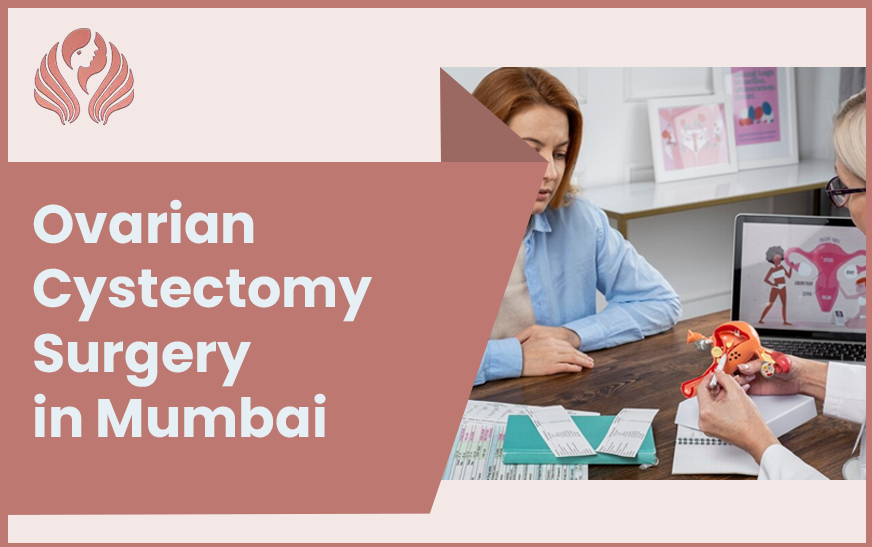Common growths that appear on or inside your ovaries are called ovarian cysts. Cysts come in several forms. The most prevalent types are symptomless, and harmless and eventually disappear without medical intervention. However, cysts can occasionally result in issues that need to be addressed by a skilled gynaecologist. Those facing issues or having symptoms indicating ovarian cysts can benefit from this blog. This blog is prepared by taking invaluable insights from the top gynaecologist provider for ovarian cystectomy surgery in Mumbai, Dr. Chaitali Mahajan Trivedi. The aim is to provide comprehensive information on ovarian cyst symptoms, causes, treatments, and more.
An Overview of Ovarian Cysts
Fluid-filled sacs of various sizes that can form in or on the ovaries are called ovarian cysts. They may frequently arise from ovulation, the irregular monthly release of eggs in which the ovarian follicles cannot release the oocyte. However, among women who have regular periods, the formation of functional ovarian cysts, which are primarily non-cancerous, is common.
These cysts are less likely to develop after menopause and may go away on their own without therapy (they typically decrease in one to three months). A person is more likely to develop ovarian cancer if they are discovered after menopause. An ovarian cystectomy, a procedure to remove cysts, may be advised if there are several or larger ovarian cysts.
What are the Symptoms of Ovarian Cysts?
-
a strong or dull discomfort in the abdomen, usually on one side.
-
irregular menstruation.
-
constipation.
-
nausea and vomiting.
-
bloating.
-
the sensation of fullness following a little meal.
-
Dyspareunia, or pain during sexual activity.
Persistent symptoms may be a sign of polycystic ovarian syndrome (PCOS). Period irregularities and other hormone-related issues, such as obesity and infertility, are symptoms of PCOS. Additional signs of polycystic ovarian syndrome include trouble losing weight and hirsutism, or increased body hair growth.
What are the Causes of Ovarian Cysts?
Some of the causes of ovarian cysts are mentioned below:
-
Hormone changes, including those caused by ovulation-promoting drugs.
-
Endometrioma, a sort of ovarian cyst, can develop as a result of endometriosis, a disorder in which the endometrial lining develops outside the uterus. This happens when the ovary and endometrial tissue attach and grow together.
-
Early Pregnancy: Ovarian cysts that develop in the early stages of pregnancy are normal since they can sustain the fetus until the placenta develops.
-
Polycystic Ovarian Symptom: The condition known as polycystic ovary syndrome is characterized by the development of several little cysts in the ovaries, which may subsequently cause issues during pregnancy.
-
Pelvic Infection: Infections in the pelvic region can travel to the ovaries and cause cysts.
What are the Effective Treatment for Ovarian Cysts?
The different types of ovarian cyst treatment include the following:
Without compromising the ovary or female fertility, ovarian cystectomy surgery attempts to remove one or more cysts from one or both ovaries. Laparoscopic surgery and open surgery (laparotomy) are the two methods used to remove ovarian cysts.
-
Open Surgery (Laparotomy): To access the cyst and surrounding tissues, open surgery involves a large abdominal incision. When there have been difficulties during laparoscopic surgery, or the cyst appears suspicious, this approach is recommended for large or numerous cysts. To check for ovarian cancer, these excised cysts might be sent to a lab. The female may become sterile if the surgeon determines that the cyst is cancerous, in which case the ovaries, fallopian tubes, other ovaries, and uterus may be removed.
-
Laparoscopic Surgery: A laparoscope, a tiny tube with a camera and special light at one end, is inserted to view the inside of the ovary on a monitor and remove the cysts during minimally invasive laparoscopic surgery. A few tiny incisions (one to four keyhole-sized, leaving 0.5-1 cm long scars) are made in the abdomen (near the navel). This technique is used when the cysts are little (like a plum or smaller) and seem benign on ultrasonography.
The best way to observe the female pelvic and abdominal organs is through a laparotomy. Under general anaesthesia, either of the two surgical techniques is carried out. Following the removal of the cysts, the incisions are sealed with skin glue, staples, or dissolvable or removable stitches that are removed five to seven days after surgery. After 24 hours, the dressing needs to be taken off.
Why are Cysts in the Ovaries Surgically Removed?
To remove the ovarian cysts producing symptoms, confirm the diagnosis of an ovarian cyst, and lower the chance of developing ovarian cancer, surgery is performed.
Some persons may be candidates for ovarian cystectomy if:
-
Both ovaries have unusual growths or lumps, as seen on the ultrasound.
-
In two to three months, ovarian cysts do not shrink or disappear after many menstrual cycles.
-
The ultrasound report does not identify the cyst as a straightforward, functional cyst.
-
The patient has undergone menopause, has ovarian growth, has never had a period (as a young girl), and is on birth control tablets.
-
There are specific ovarian features that indicate ovarian cancer.
Consult the Top Gynaecologist in Mumbai for Ovarian Cyst Examination & Treatment
If a gynaecologist discovers an ovarian cyst during a pelvic exam or ultrasound, don’t worry; they are common and mostly harmless. Most likely, your cyst will disappear in a month or two because it was a regular part of your menstrual cycle. If the doctor discovers a cyst that raises concerns, do as they advise. Make an appointment for routine pelvic exams so your doctor can identify any cysts early and treat them if necessary. You can get help from the best and leading gynaecologist in Mumbai, Dr. Chaitali Mahajan Trivedi. The expert doctor has 26+ years of experience in this field and has helped many patients achieve a pain-free and stress-free life. The doctor offers medication and surgical treatments to deal with the problem.
To learn more, book a consultation with Dr. Chaitali Mahajan Trivedi at Nanavati Super Speciality Hospital.
